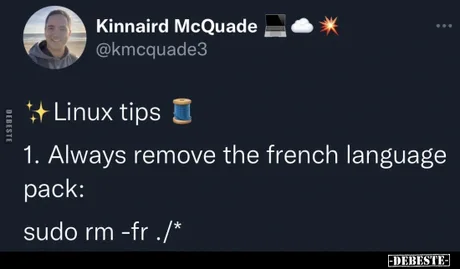this post was submitted on 12 Nov 2024
772 points (91.2% liked)
linuxmemes
27101 readers
2401 users here now
Hint: :q!
Sister communities:
Community rules (click to expand)
1. Follow the site-wide rules
- Instance-wide TOS: https://legal.lemmy.world/tos/
- Lemmy code of conduct: https://join-lemmy.org/docs/code_of_conduct.html
2. Be civil
- Understand the difference between a joke and an insult.
- Do not harrass or attack users for any reason. This includes using blanket terms, like "every user of thing".
- Don't get baited into back-and-forth insults. We are not animals.
- Leave remarks of "peasantry" to the PCMR community. If you dislike an OS/service/application, attack the thing you dislike, not the individuals who use it. Some people may not have a choice.
- Bigotry will not be tolerated.
3. Post Linux-related content
- Including Unix and BSD.
- Non-Linux content is acceptable as long as it makes a reference to Linux. For example, the poorly made mockery of
sudoin Windows. - No porn, no politics, no trolling or ragebaiting.
4. No recent reposts
- Everybody uses Arch btw, can't quit Vim, <loves/tolerates/hates> systemd, and wants to interject for a moment. You can stop now.
5. 🇬🇧 Language/язык/Sprache
- This is primarily an English-speaking community. 🇬🇧🇦🇺🇺🇸
- Comments written in other languages are allowed.
- The substance of a post should be comprehensible for people who only speak English.
- Titles and post bodies written in other languages will be allowed, but only as long as the above rule is observed.
6. (NEW!) Regarding public figures
We all have our opinions, and certain public figures can be divisive. Keep in mind that this is a community for memes and light-hearted fun, not for airing grievances or leveling accusations. - Keep discussions polite and free of disparagement.
- We are never in possession of all of the facts. Defamatory comments will not be tolerated.
- Discussions that get too heated will be locked and offending comments removed.
Please report posts and comments that break these rules!
Important: never execute code or follow advice that you don't understand or can't verify, especially here. The word of the day is credibility. This is a meme community -- even the most helpful comments might just be shitposts that can damage your system. Be aware, be smart, don't remove France.
founded 2 years ago
MODERATORS
you are viewing a single comment's thread
view the rest of the comments
view the rest of the comments

No, this is a very old joke that uses the fact the command has "fr" in it to trick people about what the command does. Joking aside, here's what the command actually does:
rmis the command to delete files and folders-fis the force modifier. This means it'll keep going even if it encounters problems and just delete as much as it can-ris the recursive modifier. That means it'll go down every folder it sees in the target and delete the contents as well, and delete the contents of folders of folders, etc./is the target. This is the root of the filesystem. If you're used to Windows, that's like targetingC:.Put it all together, and this command basically deletes your whole filesystem. A safeguard was put in place a while back due to people meming about this and causing newbies to delete their whole system. Now it won't work unless you put in
--no-preserve-root, which tellsrmthat yes, you really mean it, please delete my whole system./*as the target works around that safeguard, because technically deleting everything in root is not the same as deleting root itself.Oh, like a more sophisticated version of the old "put your phone in the microwave"joke!
Thank you, kind person.
Or the less destructive, "Press Alt+F4 to triforce."
All I see is *******